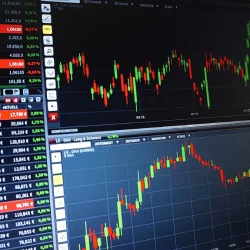Staying Calm Amid Market Uncertainty
Investing in uncertain markets can be stressful, but maintaining composure is crucial for long-term success. Warren Buffett, in his 2017 letter, emphasized the importance of staying calm and focusing on the fundamentals. Warren Buffet wrote in his 2017 letter to shareholders, “There is simply no telling how far stocks can fall in a short period.” But should a major decline occur, he continued, “heed these lines” from Rudyard Kipling’s classic poem “If,” circa 1895.
“If you can keep your head when all about you are losing theirs ... If you can wait and not be tired by waiting ... If you can think — and not make thoughts your aim ... If you can trust yourself when all men doubt you ... Yours is the Earth and everything that’s in it.”
During periods of market volatility, it's essential to avoid making hasty decisions based on short-term fears and instead maintain a focus on long-term goals.
Many investors struggle with the temptation to make rapid changes to their portfolios in response to market swings. However, these knee-jerk reactions can often lead to poor investment decisions. It’s important to remember that market corrections, although nerve-wracking, are a natural part of the investment cycle and often present opportunities for rebalancing and strengthening your portfolio.
Seeking guidance from trusted financial advisors can provide the reassurance needed to stay the course. They can offer tailored strategies to navigate volatility and help ensure that your investment plan remains aligned with your long-term financial objectives. Staying disciplined and informed is key to weathering financial storms.
The Power of Diversification
Diversification is a powerful tool in safeguarding your portfolio against market downturns. By spreading investments across various assets, you reduce risk. The Financial Industry Regulatory Authority advises that diversification strategies should be personalized, and it may be beneficial to consult with an investment professional to tailor your approach. Many investors have a US home bias, but with only 26% of the world's GDP coming from the US, the remaining 74% presents numerous global investment opportunities. A well-diversified portfolio captures growth from different parts of the world, offering a buffer against domestic market fluctuations.
Smart Asset Allocation
A thoughtful mix of asset classes can enhance portfolio stability. Owning a variety of assets, including non-US investments, helps navigate market volatility. Allocating around 30% of your portfolio to international companies can mitigate risks associated with domestic market shifts.
Diversification among asset classes, such as stocks, bonds, and international investments, is vital for managing risk. Market leadership often shifts, making it unwise to rely solely on one type of investment. By spreading your investments across different asset classes and regions, you capture growth from various sources, which can buffer against downturns in any single area. The historical performance of different asset classes also demonstrates randomness, emphasizing the need for a well-rounded approach. For example, one year might see tech stocks leading, while the next could have bonds or international markets at the forefront. A diversified portfolio not only helps manage risk but also positions you to benefit from various market conditions over the long term.
Bonds: Your Financial Stabilizers
Bonds serve as crucial components in a well-balanced investment portfolio, providing stability during periods of market volatility. Unlike stocks, which can experience significant price swings, bonds typically offer more predictable returns. For instance, during a downturn led by tech stocks, bonds can act as a buffer, mitigating the impact on your overall portfolio. So far in 2025, specific bond indices like VCSH and VGSH managed to post modest gains even as equities faced challenges. This contrasting performance highlights the role bonds play in cushioning against market dips. Furthermore, international bonds add another layer of diversification, reducing the risk tied to any single market. By including a mix of bonds in your investment strategy, you create a more resilient portfolio capable of weathering various market conditions. The steady income from bond interest can also provide a reliable revenue stream, making them particularly valuable during uncertain economic times.
Tariffs and Their Long-Term Impact
Tariffs can spark immediate market anxiety, with fears of rising inflation and increased consumer costs. However, their long-term impact often proves to be limited. While tariffs may initially disrupt trade and cause price hikes, the overall effect on the US economy tends to be minimal. This is largely because consumer spending, not net exports, drives the majority of US GDP growth. As businesses and markets adapt to new tariff structures, the initial shock usually fades, allowing economic activity to normalize. Over time, industries often find ways to mitigate the effects of tariffs through various strategies, such as sourcing materials from alternative suppliers or passing costs onto consumers. Consequently, the economic landscape adjusts, and the broader economy continues to grow. While tariffs may create short-term volatility, their long-term influence is generally muted, allowing other economic drivers to take the forefront.
Understanding Cash in Your Portfolio
During times of market turbulence, many investors seek the safety of cash, perceiving it as a secure option. However, this sense of safety can be deceptive due to the persistent impact of inflation. While cash can provide stability in the short term, it does not offer the potential for growth that other investments do. Inflation erodes the purchasing power of cash over time, meaning that the money you hold today will not buy as much in the future. Certificates of Deposit (CDs) and other cash-equivalent investments often yield returns that, when adjusted for inflation, are negative. This loss of purchasing power highlights the importance of maintaining a portion of your portfolio in assets that can outpace inflation, such as stocks. Historical performance shows that equities have the potential to generate significant long-term returns, helping to grow your wealth even as prices rise. While cash has its place for liquidity and emergency funds, relying too heavily on it can hinder your financial growth and erode the real value of your savings.
Embracing Market Corrections
Market corrections are an expected aspect of investing and can serve as valuable opportunities for those who remain patient. Historical data shows that markets not only recover from these corrections but often emerge stronger. Instead of viewing a correction as a setback, consider it a chance to evaluate and rebalance your portfolio. For disciplined investors, buying during market dips can lead to substantial long-term gains. On average, corrections involve a drop of about 14% and a recovery within less than four months. This pattern demonstrates that temporary downturns are not only survivable but also offer the potential for strategic adjustments that enhance long-term returns. Warren Buffett aptly advises, “When it’s raining gold, reach for a bucket,” underscoring the importance of seizing opportunities during market declines. By staying informed and maintaining a long-term perspective, investors can turn market corrections into pivotal moments for growth and portfolio enhancement.
Commitment to Staying Invested
Remaining in the market during downturns is essential for capturing subsequent rebounds. Exiting during periods of pessimism often results in missed opportunities and significantly lower returns. Emotional reactions, such as selling investments in a panic, can derail long-term financial goals. Historical data shows that markets tend to recover and reward those who stay invested. Attempting to time the market consistently fails, as it’s nearly impossible to predict the best moments to enter or exit. Missing just a handful of the market’s best-performing days can drastically impact overall returns.
This underscores the importance of maintaining a steady investment strategy, even when market conditions seem bleak. For instance, during volatile periods, investors might be tempted to liquidate their holdings and move to cash or other perceived safe havens. However, as discussed earlier, these choices often fail to keep up with inflation and erode purchasing power.
Instead, sticking with a diversified and balanced portfolio helps weather short-term market fluctuations and positions investors to benefit from long-term growth. Automated rebalancing strategies can aid in maintaining your portfolio’s intended asset allocation, ensuring that it remains aligned with your risk tolerance and financial objectives. Consulting with a financial advisor can provide additional guidance and reassurance, helping you stay committed to your investment plan.
Ultimately, the key to long-term success is maintaining discipline and avoiding the urge to make hasty decisions based on market sentiment. By staying invested, you increase your chances of achieving your financial goals and securing a more stable financial future.
Conclusion: The Path to Success
Success in long-term investing relies heavily on discipline and a well-structured approach. Diversification spreads risk across different asset classes and global markets, offering resilience against market fluctuations. Smart asset allocation ensures your investments are balanced, combining various assets to reduce volatility and capture growth. Consistent rebalancing keeps your portfolio aligned with your financial goals and risk tolerance, adjusting for market changes without succumbing to emotional reactions. By maintaining these strategies, you can confidently navigate market uncertainty and work towards achieving financial stability. Ultimately, a disciplined, informed approach is key to building a secure and prosperous financial future.
* This article is provided for informational purposes only and is not intended to be considered as tax, legal, or investment advice.
More to Read:
Previous Posts:




